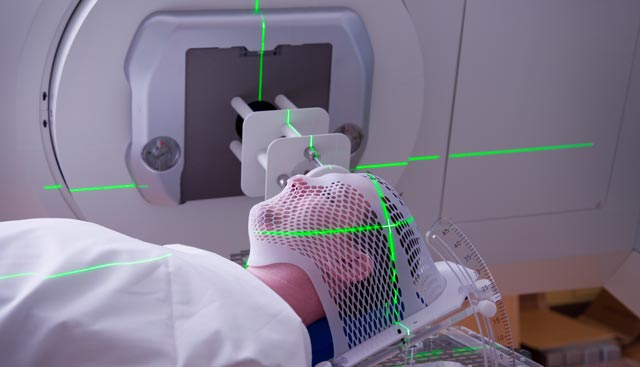Brachytherapy

Brachytherapy—also known as internal radiation therapy—is a type of radiation therapy in which cancer-fighting radiation is emitted from a source inside the body. This is in contrast to external beam radiation therapy, which involves aiming radiation beams at a tumor from an external machine. Brachytherapy implants (often referred to as seeds) can be inserted for a short period of time and removed once the treatment is complete, or they may be left in place after all of the radiation has been released.
What does brachytherapy treat?
Several types of cancer tend to respond positively to brachytherapy treatment, including:
- Brain cancer
- Breast cancer
- Cervical cancer
- Esophageal cancer
- Head and neck cancers
- Lung cancer
- Prostate cancer
- Rectal cancer
- Soft tissue sarcomas
- Vaginal cancer
- Uterine (endometrial) cancer
- Cancers affecting the eye
Patients with other types of cancer may also benefit from brachytherapy.
How is brachytherapy performed?
During a brachytherapy procedure, a surgeon carefully implants the radiation source into the body through an applicator or a small, flexible tube known as a catheter. Depending on the patient’s cancer and diagnosis, the radiation source may be placed:
- Directly into the tumor (interstitial brachytherapy)
- Into an existing cavity, such as the vagina, or a surgically created cavity (intracavity brachytherapy)
- Onto the eye, in cases of ocular melanoma (episcleral brachytherapy)
What are the advantages of brachytherapy?
With brachytherapy, radiation oncologists are able to administer a high dose of radiation to a tumor while reducing exposure to the surrounding healthy tissues. This, in turn, can help reduce the side effects that might otherwise occur if healthy cells sustain damage from the radiation. Other advantages of brachytherapy include:
- Shorter courses of treatment. While external beam radiation therapy is often spread out over the course of several weeks or months, a course of brachytherapy is typically completed within one to five days.
- Fewer trips to physicians’ offices. This is especially true when the implants are left inside a patient’s body after the treatment is finished. Patients will still have follow-up visits and routine monitoring, but typically do not need to see a radiation oncologist multiple times per week (as is generally the case with external beam radiation therapy).
- Shorter recovery times. Although every patient responds differently to treatment, brachytherapy can be less damaging to healthy tissues, allowing for faster recoveries in many situations.
What are the types of brachytherapy?
There are two main types of brachytherapy:
- Temporary brachytherapy. As its name suggests, temporary brachytherapy involves placing a radiation source inside the body for a specific period of time. Low-dose rate (LDR) seeds can be in place continuously for one to seven days, while high-dose rate (HDR) seeds may be inserted for 10 to 20 minutes at a time over the course of several days or weeks.
- Permanent brachytherapy. In permanent brachytherapy, the seed remains in the patient’s body for the rest of their life. The radiation source will continue to weaken every day and will eventually stop emitting radiation altogether.
Does brachytherapy cause side effects?
Any medical treatment has the potential to cause side effects, including brachytherapy. The most common side effects of brachytherapy include tenderness, bruising, swelling, pain and bleeding around the radiation site. When brachytherapy is used to treat prostate or gynecologic cancers, temporary urinary or digestive symptoms may occur.
Moffitt’s approach to brachytherapy
At Moffitt Cancer Center, brachytherapy is one of several advanced treatments provided by our expert radiation oncologists. Each patient’s needs are collaboratively reviewed to determine the best approach to radiation therapy, and every single aspect of a patient’s treatment—from the radiation dosage to the delivery schedule—can be tailored to achieve the best possible outcome. Furthermore, a wide range of supportive care services are also offered at Moffitt, allowing patients to maintain a high quality of life throughout treatment, regardless of which types of treatment they pursue.
Consultations with our radiation oncologists are available with or without referrals. To learn more about brachytherapy or any of our other precisely targeted treatments, call Moffitt at 1-888-663-3488 or submit a new patient registration form online. Our team is actively working to streamline access to world-class cancer care and will respond to your request within 24 hours.
References
National Cancer Institute: Brachytherapy to Treat Cancer
RadiologyInfo.org: Brachytherapy
Radiation Therapy
- 3D CRT (Three-Dimensional Conformal Radiation Therapy)
- Adaptive Radiotherapy
- APBI (Accelerated Partial Breast Irradiation)
- Brachytherapy
- Common Questions
- CT-Driven Virtual Simulations
- External Radiotherapy
- IGRT (Image Guided Radiation Therapy)
- IMRT (Intensity Modulated Radiation Therapy)
- Internal Radiotherapy
- INTRABEAM® Intraoperative Radiotherapy
- Linear Accelerator (LINAC)
- MRI-Linac
- On-Board Imaging (OBI)
- Radiopharmaceuticals
- Respiratory Gating
- SBRT (Stereotactic Body Radiation Therapy)
- Stereotactic Radiosurgery
- Total Body Irradiation (TBI)
- Total Skin Electron Therapy (TSET)
- Volumetric Modulated Arc Therapy (VMAT)
